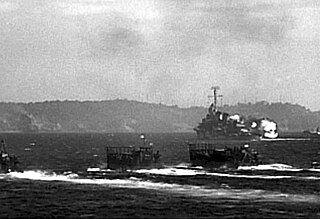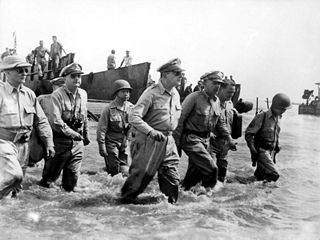 W
WThe Angels of Bataan were the members of the United States Army Nurse Corps and the United States Navy Nurse Corps who were stationed in the Philippines at the outset of the Pacific War and served during the Battle of the Philippines (1941–42). When Bataan and Corregidor fell, 11 Navy nurses, 66 army nurses, and 1 nurse-anesthetist were captured and imprisoned in and around Manila. They continued to serve as a nursing unit while prisoners of war. After years of hardship, they were finally liberated in February 1945.
 W
WThe Battle of Baguio occurred between 21 February and 26 April 1945, and was part of the greater Luzon campaign during the Allied liberation of the Philippines at the end of World War II. During the battle, American and Philippine forces recaptured the city of Baguio on the island of Luzon from a Japanese occupation force. One of the last tank engagements of the Philippine campaign took place during the battle. Baguio later became the scene of the final surrender of Japanese forces in the Philippines in September 1945.
 W
WThe Battle for the Recapture of Corregidor, which occurred on the 16th until the 26th of February, 1945, pitted American forces against the defending Japanese garrison on the island fortress. The Japanese had captured the bastion from the United States Army Forces in the Far East during their 1942 invasion.
 W
WThe Battle of Luzon, was a land battle of the Pacific Theater of Operations of World War II by the Allied forces of the U.S., its colony the Philippines, and allies against forces of the Empire of Japan. The battle resulted in a U.S. and Filipino victory. The Allies had taken control of all strategically and economically important locations of Luzon by March 1945, although pockets of Japanese resistance held out in the mountains until the unconditional surrender of Japan. While not the highest in U.S. casualties, it is the highest net casualty battle U.S. forces fought in World War II, with 192,000 to 205,000 Japanese combatants dead, 8,000 American combatants killed, and over 150,000 Filipinos, overwhelmingly civilians who were murdered by Japanese forces, mainly during the Manila massacre of February, 1945.
 W
WThe Raid at Cabanatuan, also known as The Great Raid, was a rescue of Allied prisoners of war (POWs) and civilians from a Japanese camp near Cabanatuan City, Philippines. On January 30, 1945, during World War II, United States Army Rangers, Alamo Scouts and Filipino guerrillas liberated more than 500 from the POW camp.
 W
WThe Battle for Cebu City was a major engagement of World War II that occurred between March 26 and April 8, 1945, during the second Philippines Campaign. The battle resulted in an Allied victory over the occupying Japanese Army and the liberation of Cebu City.
 W
WThe Battle of Davao was a major battle in which American and Philippine Commonwealth troops including locally organized guerrillas fought the Japanese to liberate the city of Davao. The battle is part of Operation VICTOR V, an offensive operation against Japanese forces in Mindanao, and part of the campaign for the liberation of the Philippines during World War II. The battle was the decisive engagement of the Mindanao Campaign.
 W
WThe Invasion of Lingayen Gulf, 6–9 January 1945, was an Allied amphibious operation in the Philippines during World War II. In the early morning of 6 January 1945, a large Allied force commanded by Admiral Jesse B. Oldendorf began approaching the shores of Lingayen. U.S. Navy and Royal Australian Navy warships began bombarding suspected Japanese positions along the coast of Lingayen from their position in Lingayen Gulf for three days. On 9 January, the U.S. 6th Army landed on a 20 mi (32 km) beachhead between the towns of Lingayen and San Fabian.
 W
WThe De La Salle Brothers - Philippine District is part of the Institute of the Brothers of the Christian Schools, the largest congregation of Roman Catholic religious Brothers who are exclusively dedicated to education. The Institute was founded in Reims, France in 1680, with over 75,000 Brothers and lay colleagues who conduct schools as well as educational works in about 82 countries worldwide.
 W
WThe Battle of Manila was a major battle of the Philippine campaign of 1944–45, during the Second World War. It was fought by forces from both the United States and the Philippines against Japanese troops in Manila, the capital city of the Philippines. The month-long battle, which resulted in the death of over 100,000 civilians and the complete devastation of the city, was the scene of the worst urban fighting in the Pacific theater. Japanese forces committed mass murder against Filipino civilians during the battle. Along with massive loss of life, the battle also destroyed architectural and cultural heritage dating back to the city's founding, and Manila became one of the most devastated capital cities during the entire war, alongside Berlin and Warsaw. The battle ended the almost three years of Japanese military occupation in the Philippines (1942–1945). The city's capture was marked as General Douglas MacArthur's key to victory in the campaign of reconquest. It is the last of the many battles fought within Manila's history.
 W
WThe Manila massacre, also called the Rape of Manila, involved atrocities committed against Filipino civilians in the City of Manila, the capital of the Philippines, by Japanese troops during the Battle of Manila which occurred during World War II. The total number of civilians who were killed during the battle of Manila was about 100,000.
 W
WThe Battle of Mindanao was fought by the Americans and allied Filipino guerrillas against the Japanese forces on the island of Mindanao in the Philippines as part of Operation VICTOR V. It was part of the campaign to liberate the Philippines during World War II. The battle was waged to complete the recapture of the southernmost portions of the archipelago from the Imperial Japanese Army.
 W
WThe Philippines campaign, Battle of the Philippines or the Liberation of the Philippines, codenamed Operation Musketeer I, II, and III, was the American and Filipino campaign to defeat and expel the Imperial Japanese forces occupying the Philippines during World War II. The Japanese Army overran all of the Philippines during the first half of 1942. The liberation of the Philippines commenced with amphibious landings on the eastern Philippine island of Leyte on October 20, 1944. United States and Philippine Commonwealth military forces were progressing in liberating territory and islands when the Japanese forces in the Philippines were ordered to surrender by Tokyo on August 15, 1945, after the dropping of the atomic bombs on mainland Japan and the Soviet invasion of Manchuria.
 W
WThe Raid on Los Baños in the Philippines, early Friday morning on 23 February 1945, was executed by a combined U.S. Army Airborne and Filipino guerrilla task force, resulting in the liberation of 2,147 Allied civilian and military internees from an agricultural school campus turned Japanese internment camp. The 250 Japanese in the garrison were killed. It has been celebrated as one of the most successful rescue operations in modern military history. It was the second precisely-executed raid by combined U.S.-Filipino forces within a month, following on the heels of the Raid at Cabanatuan at Luzon on 30 January, in which 522 Allied military POWs had been rescued. The air/sea/land raid was the subject of a 2015 nonfiction book, Rescue at Los Baños: The Most Daring Prison Camp Raid of World War II, by New York Times bestselling author Bruce Henderson. The history of the airborne rescuing force, the 11th Airborne Division, is covered in the 2019 book, When Angels Fall: From Toccoa to Tokyo, the 511th Parachute Infantry Regiment in World War II by author Jeremy C. Holm.
 W
WThe Battle of the Visayas was fought by U.S. forces and Filipino guerrillas against the Japanese from 18 March – 30 July 1945, in a series of actions officially designated as Operations Victor I and II, and part of the campaign for the liberation of the Philippines during World War II. The battle was waged to complete the recapture of the central portions south of the archipelago and secure them from remaining Japanese forces.